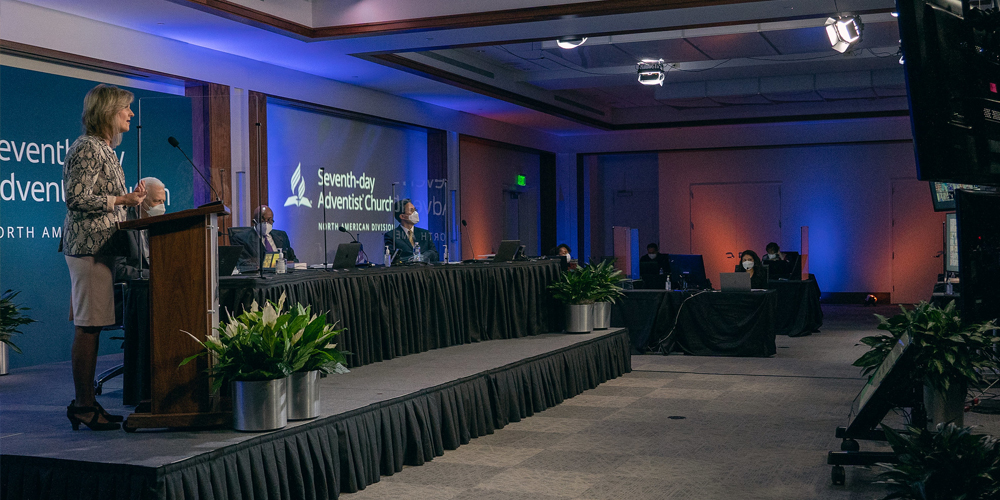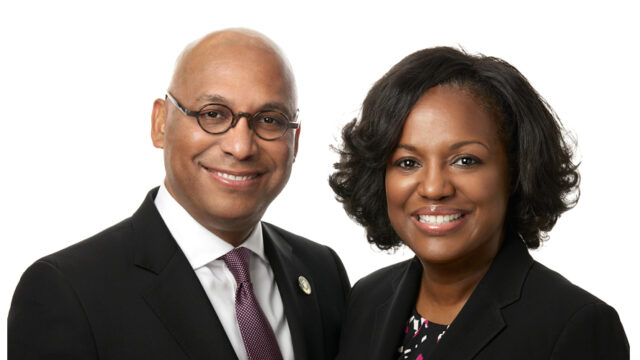Health leader in the North American Division calls for greater awareness, interventions.

On November 3, 2020, Bonita Shields, North American Division vice president for ministries, started the final breakout of the 2020 NAD Year-End Meeting. Shields explained that the mental health segment would include a survey, a video, and small-group breakout sessions. She then introduced Angeline Brauer, NAD Health Ministries director, who coordinated the poll that executive committee delegates answered through a Zoom pop-up.
Before getting into the poll, Brauer set the scene. “The purpose [of this session] is to foster awareness and to create synergy. That is what we want to accomplish today,” she said. “With our poll, what we want to do is form a foundation for where we’re going to start our conversation.”
The poll included multiple-choice, true or false, and yes or no answers to seven questions or statements: “In your ministry, how often does someone come to you with a personal health concern?” “How comfortable do you feel helping someone who comes to you with a mental health concern?” “How aware are you of resources, whether in your local church or your local community to help individuals who are having a mental health problem?” “Have you or someone in your family ever experienced a mental health issue?” “The only way to heal mental health problems is through prayer.” “People with mental health needs are unable to hold down a job.” “Once a person develops mental health problems, they will never recover.”
After commenting on pooled poll results, Brauer introduced “The Manic Monologues,” a film produced by Stanford University students and faculty and shared with the executive committee by AdventHealth, which bought the rights to show the film, with the primary purpose of helping to break down stigmas about mental health and illness. Delegates watched real stories of people who experienced (and still experience) mental illness with themselves, friends, or family.
“Our goal is to raise awareness and synergy across all of our organizations,” Brauer reiterated. “We are all at risk of experiencing a mental illness. In Genesis, we read about how mental and emotional brokenness enters the world. All of us come into the world with some element of this brokenness. That puts us at risk of experiencing mild, moderate, or maybe even severe mental illnesses. And not only that, simply living in the year 2020 has exposed every single one of us to trauma, whether personally or through what we’ve seen others go through—that also puts us at risk.”
Brauer shared statistics from the National Alliance on Mental Illness that one in five adults in the United States experience a mental illness in a given year. Since 2016, the percentage of young adults experiencing mental illness has jumped to more than 26 percent, or one in four.
In Bermuda, Brauer said, about 15 percent of adults and 10 percent of children experienced mental illness. In Guam, 13 to 15 percent of adults and about 7 percent of children had experienced a mental illness in 2018 and 2019. “And in Canada,” she said, “we see that 50 percent, or one in two Canadians, will have a mental illness by age 40, or will have experienced a mental illness.”
“This should not be a surprise to us, but it should be a call,” Brauer added. She shared that in the book Troubled Minds, Mental Illness, and the Church’s Mission, Amy Simpson writes that 45 percent of church pastors report that they are approached for help with a mental health problem two to five times a year; while another 33 percent of pastors say that they are asked for help six or more times a year.
“What this tells me is that people do come to the church looking for help. And we need to know how to get them the best help possible for their particular situation, their specific needs. We need to know who, what, and where are those resources,” Brauer said, noting that this data was collected before the COVID-19 pandemic. “Mental illnesses, as well as accompanying issues of domestic violence, abuse, and addictions, have all grown during these past months. So we cannot ignore the issue. I believe it is incumbent upon us to do our part. There is hope. May God help each of us to be ministers of the hope and wholeness that He gives through the healing power of Christ.”
After these remarks, delegates were separated into small groups to discuss the following questions or topics: “What stigmas or misunderstandings about mental health exist in the Adventist Church?”; “What one message would you want to give a non-Adventist about how Adventists view mental health?”; “What can you do to address mental health in the organization you represent?”; and “How can the NAD help you.”
Pastors, administrators, educators, college students, and other church leaders spent 30 minutes in dialogue. In those groups, many addressed the need to remove the stigma from mental illness and the need for more (and continual) training and resources. Notes from the groups will later be shared with the division.
Near the close of the special session, as delegates gathered again in the general meeting, NAD president Alexander Bryant shared his thoughts. He talked about the numbers Brauer shared of those suffering in the general population and compared them to the Zoom meeting group. “It would mean that 50 out of 250 of us have some mental illness, diagnosed or undiagnosed,” he said. “That’s how prevalent it is in our society, and what impacts our society also impacts our church.”
“As [Dr. Brauer] said, if someone broke their ankle, we wouldn’t ‘spiritualize’ it and just say go pray about it. We’d create a safe place for them to go and get assistance and help,” Bryant added. “Don’t you think the [1.2 million Adventists in the NAD] can have an impact on helping to destigmatize and offering a safe place? We can make our brothers and sisters feel like they’re a part of our community, that they can share and not have to hide if they have a mental illness.”
The original version of this story was posted on the North American Division news site.








